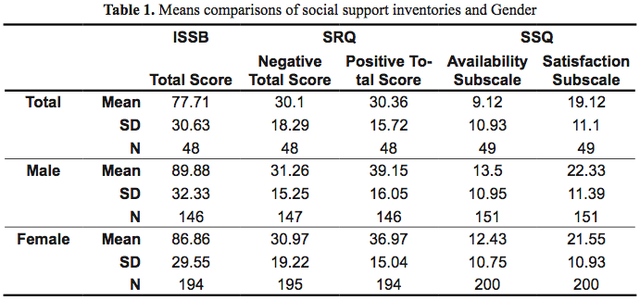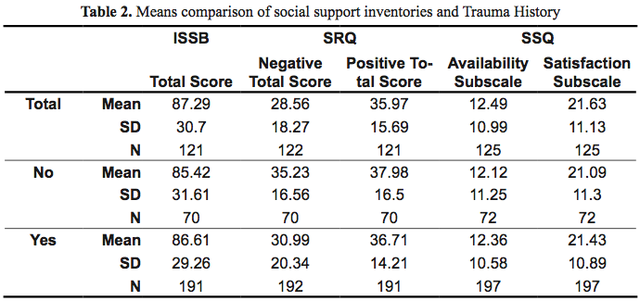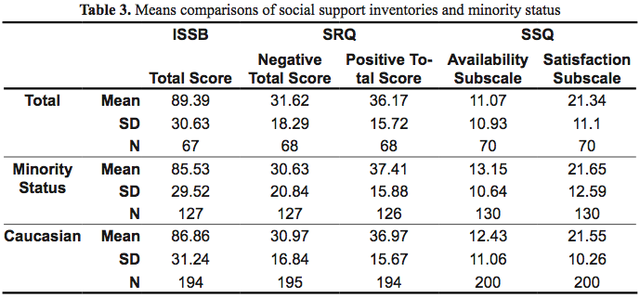From Discussions VOL. 8 NO. 2Social Support in PTSD: An Analysis of Gender, Race, and Trauma TypeDiscussionThe current study revealed three main findings after analyzing data from a sample of 200 men and women diagnosed with PTSD. 1) Women reported significantly lower levels of social support than men; 2) the differences between non-CSA and CSA trauma were negligible; in fact, those reporting a trauma that did not involve childhood sexual assault had higher levels of negative social support and 3) Minority status was a non-significant factor in social support; actually, there was some evidence that minority status slightly correlated (though not significantly) with higher levels of social support. We found that womens’ low levels of social support were congruent with our hypothesis and previous research that alludes to the idea that women have a harder time finding positive social support than men. This study further supports the idea that women may be more vulnerable after trauma, due to their lack of positive social support (and increased levels of negative social support), than men, are after trauma. This could also allude to the different kinds of trauma men and women generally face; with women more likely to face sexual assault (17.6% of women vs. 3% of men), and men more likely to face trauma from combat exposure (57.1% of men developed PTSD; 27.8% of women developed PTSD) (U.S. Dept. Justice, 2005; Pereira, 2002). Victims of combat may be more likely to receive positive support (family, friends, and the VA) after having experienced trauma than victims of sexual assault. Therefore, it is possible that, because men are more likely to experience combat trauma and women experience sexual trauma, the levels of social support for men and women may be markedly different. Because two of the assessment instruments used only measured perceived social support, this may have altered the data outcomes. It is possible that women perceive social support more negatively than men, but we did not find research to support this hypothesis.
Trauma-type did not appear to be a significant factor in the levels of social support. We did find that those who experienced trauma, that was not childhood sexual assault, experienced significantly higher levels of negative social support than those who did experience childhood sexual assault. The data found in this study challenges the conventional notion that survivors of childhood sexual assault receive less social support. Research shows that childhood sexual assault is consistently underreported and seldom disclosed (Herman, 1981; Russell, 1983; Summit, 1983). Because children may not disclose or report their trauma to others, they may not receive the negative social support that may come with other kinds of trauma that people disclose more readily. Additionally, this study only examined whether or not the participant reported childhood sexual assault; we did not examine if childhood sexual assault was the primary trauma that caused their PTSD diagnosis. We also compared childhood sexual assault to all other traumas. Consequently, this pitted CSA against adult sexual assault survivors, perhaps concealing data patterns that showed that sexual assault survivors, in general (whether it occurred in childhood or adulthood), may experience lower levels of social support or higher levels of negative social support. Although we found no statistical significance in the relationship between social support and minority status, we did find that minorities scored slightly higher in social availability and satisfaction (SSQ), and also slightly higher in positive support (SRQ). However, they did score slightly lower on the ISSB. Several factors may be contributing to these results. Minority families have higher feelings of collectivism than do white families, thus stressing the importance of social support rather than dealing with a stressor or trauma on an individual level (Plant, 2004). Additionally, minorities are more likely to face hardship than whites, leading them to then seeking out social support from others (who are also facing hardship) and developing close social bonds (Gump, 1997). Minorities also tend to have larger families than whites, therefore increasing the trauma survivor’s “natural” source of social support (Taylor et al., 1996). The strength of racial and ethnic identity was not measured in this data; however, studies have shown that ethnic minorities gain a sense of their racial or ethnic identity earlier and stronger than Caucasians. This is due to the realization that they do not fit into the cultural “White paradigm,” which results in the identification of their status as non-whites (Chaves & Guido-DiBrito, 1999). A stronger sense of identity could perhaps have been a factor in developing positive social support. The data from this study suggests that women, in treatment for PTSD, may need more attention paid to them in order to improve their social support and their perceptions of social support, as well. This “specialized” treatment may involve routinely assessing female trauma survivors’ social support and analyzing whether or not they feel they are receiving adequate support, both in the therapeutic relationship and in their personal lives. The results of the current study failed to support the idea that minorities and survivors of childhood sexual assault require extra care. However, future studies may be interested in expanding these results by examining the relationship between sexual vs. non-sexual trauma to determine if sexualized trauma, in general, may be more indicative of lower levels of social support. Additionally, future studies may consider examining the levels of social support in minority families, on a more specific level, in order to find out what kinds of support exist in different races or ethnicities. It is quite likely that there is fluctuation between levels of social support between minority races or ethnicities rather than the assumption that all minorities receive the same levels of social support. AcknowledgmentsI would like to thank Dr. Norah Feeny for overseeing my project and for her excellent suggestions to improve my research throughout my time working with her. I could not have done this without you! ReferencesBarrera, M. (1986). Distinctions between social support concepts, measures, and models. American Journal of Community Psychology,14(4), 413–445. Berkman, L.F., & Syme, S.L. (1979). Social Relationships and Health. Advances in MindBody Health, 17, 5-7. Brewin, C.R., Andrews, B., & Valentine, J.D. (2000). Metaanalysis of risk factors for posttraumatic stress disorder in trauma-exposed adults. Journal of Consulting and Clinical Psychology. 68, 748-66. Charney DS. Psychobiological mechanisms of resilience and vulnerability: implications for successful adaptation to extreme stress. American Journal of Psychiatry.61, 195-21. Chavez, A.F., & Guido DiBrito, F. (1999). “Racial and Ethnic Identity and Development.” In New Directions Adult and Continuing Education. Vol 84. New York NY: Jossey-Bass Publishers. Cohen, S., & Wills, T.A., (1985). Stress, social support, and the buffering hypothesis. Psychological Bulletin, 98, 310-357. Foa, E., Riggs, D., Dancu, C., & Rothbaum, B.(1993). Reliability and validity of a brief instrument for assessing post-traumatic stress disorder. Journal of Traumatic Stress, 6, 459-474. Galea, S., Vlahov, D., Resnick, H., Ahern, J., Gold, J., Bucuvalas, M., & Kilpatrick. Trends of Probable Post-Traumatic Stress Disorder in New York City after the September 11 Terrorist Attacks. American Journal of Epidemiology,158, 514-524. Gump, B. B., & Kulik, J. A. (1997). Stress, affiliation, and emotional contagion. Journal of Personality and Social Psychology, 72, 305–319. Herman, J. L. (1981). Father-daughter incest. Cambridge, MA: Harvard University Press. House, J.S, Landis, K.R., & Umberson, D. (1988). Social Relationships and Health. Science, 241, 540-545. Jonzon, E., Lindblad, F. (2004). Disclosure, Reactions, and Social Support: Findings from a Sample of Adult Victims of Child Sexual Abuse. Child Maltreatment. 9(2): 190200. Kessler, R. C., Price, R. H., & Wortman, C. B. (1985). Social and cultural influences on psychopathology. Annual Review of Psychology, 36, 531-572. Ozer EJ, Best SR, Lipsey TL, Weiss DS. 2003. Predictors of posttraumatic stress disorder and symptoms in adults: A meta-analysis. Psychological Bulletin 129(1):52– 73. Pereira, A. (2002). Combat trauma and the diagnosis of post-traumatic stress disorder in female and male veterans. Military Medicine, 167(1), 23-7. Plant, E. A., & Sachs-Ericsson, N. (2004). Racial and Ethnic Differences in Depression: The Roles of Social Support and Meeting Basic Needs. Journal of Consulting and Clinical Psychology, 72(1), 41-52. Russell, D. E. H. (1983). The incidence and prevalence of intrafamilial and extrafamilial sexual abuse of female children. Child Abuse & Neglect, 7, 133-146. Sarason, I.G. , Levine, H.M., Basham, R.B. & Sarason, B.R. (1983) `Assessing Social Support: The Social Support Questionnaire’, Journal of Personality and Social Psychology, 44: 127-139. Summit, R. C. (1983). The child sexual abuse accommodation syndrome. Child Abuse & Neglect, 7, 177193. Ullman, S.E.. & Filipas, H. H. (2005). Gender differences in social reactions to abuse disclosures, post-abuse coping, and PTSD of child sexual abuse survivors. Child Abuse & Neglect, 29, 767-782. Taylor, R. J., Hardison, C. B., & Chatters, L. M. (1996). Kin and nonkin as sources of informal assistance. In H. W. Neighbors & J. S. Jackson. (Eds.), Mental health in Black America (pp. 130–145). Thousand Oaks, CA: Sage. Ullman, S. E., & Filipas, H. H. (2001). Predictors of PTSD Symptom Severity and Social Reactions in Sexual Assault Victims. Journal of Traumatic Stress, 14(2), 369. U.S. Department of Justice. 2005 National Crime Victimization Survey. 2005. Suggested Reading from Inquiries Journal
Inquiries Journal provides undergraduate and graduate students around the world a platform for the wide dissemination of academic work over a range of core disciplines. Representing the work of students from hundreds of institutions around the globe, Inquiries Journal's large database of academic articles is completely free. Learn more | Blog | Submit Latest in Psychology |




















